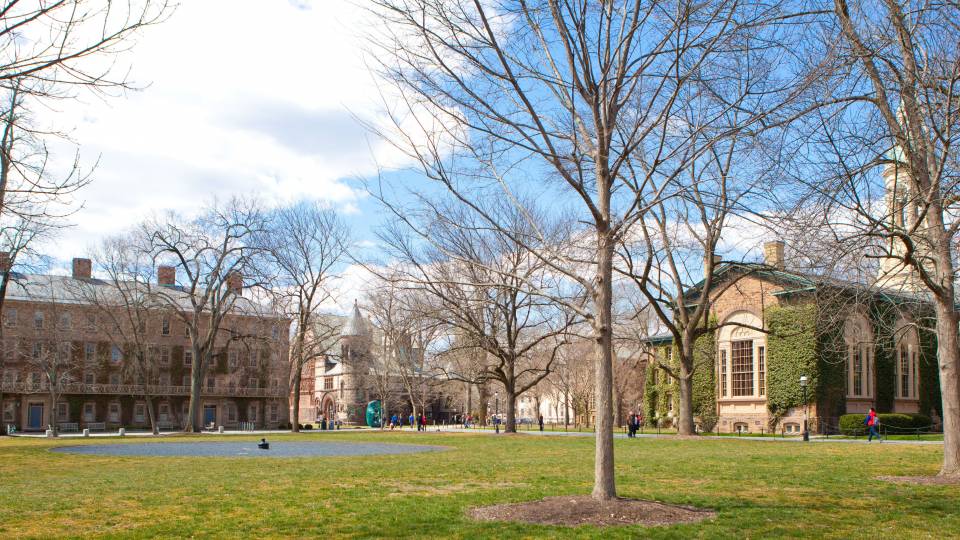In the most selective admission process in the University's history, Princeton has offered admission to 2,148, or 8.18 percent, of the record 26,247 applicants for the class of 2014. This compares to an admission rate of 9.79 percent at this time last year, and 9.25 percent the previous year.
The number of applicants for the incoming freshman class was the largest the University has seen by a significant margin, representing a 19.5 percent increase over the 21,963 candidates who applied for the class of 2013.
"This exceptionally large pool of applicants was matched by the outstanding quality of the students," said Dean of Admission Janet Rapelye. "We were impressed with the superb intellect, talent and character the candidates presented. We had to make some extremely difficult decisions."
The continued strength of Princeton's financial aid program may be an incentive as students consider the University's offer of admission, Rapelye said, in light of the challenging economic circumstances facing families across the country.
"We're mindful that many families are still struggling, even with the recent signs of economic recovery," she said. "The fact that we can help support families and students in their aspirations for higher education with our financial aid program is something we value at the highest levels."
The University expects that more than 60 percent of the class enrolling in the fall will receive need-based financial aid. The average grant is projected to exceed $36,000. Princeton has a "no-loan" policy through which financial need is met with grants instead of loans, allowing all students who qualify for financial aid to graduate debt free. Through the University's need-blind admission process, students are not at a disadvantage if they apply for financial aid.
Increases in average financial aid awards since 1998 -- the year the University launched a first wave of groundbreaking financial aid initiatives -- have continued to outpace increases in tuition. In 1998, the average student aid grant covered 65 percent of the tuition charge. For next year's entering class, the projected average aid grant is expected to cover more than 98 percent of the tuition charge. The scholarship budget for the next fiscal year is projected to rise from this year's $103 million to $112 million, an increase of nearly 9 percent.
Admitted students have an opportunity to review a brief description of their financial aid awards, in addition to learning their admission decision from the Office of Admission, through an online notification system beginning at 5 p.m. April 1. Letters informing applicants of decisions also were mailed April 1.
The University plans for the second year to enroll its new "steady state" class in the range of 1,300 students -- 1,308 are expected to enroll in the fall -- as part of the final stage of a gradual expansion of the class that began in 2005. An 11 percent overall increase in the number of undergraduates that began that fall will result in a student body of 5,200 by the 2012-13 academic year.
Among this year's applicants: more than 9,820 had a cumulative 4.0 grade point average; about 13,650 had a combined score of 2100 or higher on the three sections of the SAT; and they come from 8,393 high schools in 146 countries, including the United States. Alumni volunteers had personal contact with 99.8 percent of applicants.
Beyond the 2,148 offered admission, an additional 1,451 students were offered positions on the wait list, though only half of those students are expected to choose to stay on the wait list, as in past years.
"We were privileged to read the applications from these talented young men and women," Rapelye said, adding that the University recognizes that many wait-listed students will choose other alternatives, but several hundred are expected to remain on the wait list.
Students who ultimately are offered a position in the class in May or June will receive the same financial aid considerations as students offered admission this week.
The students receiving outright offers of admission for the class of 2014 come from all 50 states and Washington, D.C., with the largest number of students admitted from California, followed in order by New Jersey, New York, Massachusetts and Texas. International students make up 10.3 percent of the admitted students, and they are citizens of 64 countries, including Bangladesh, Brazil, Bulgaria, Chile, China, Costa Rica, France, Greece, Guatemala, Iceland, India, Israel, Jamaica, Kenya, Morocco, Myanmar, Norway, Senegal, Turkey, Uganda, Vietnam and Zambia.
The students admitted to the class of 2014 are evenly balanced: 50 percent men and 50 percent women. Admitted students self-identified among the following racial and ethnic groups: 9.4 percent as African American; 21.5 percent as Asian American; 10 percent as Hispanic or Latino; less than 1 percent as Native American; and 4.4 percent identified themselves as belonging to two or more races. Almost 19 percent of the admitted students stated plans to pursue a bachelor of science in engineering, up from 17 percent last year.
"The expansion of the freshman class has allowed us to offer this splendid education to more students," Rapelye said.
For the second year in a row, a small portion of the entering class, 20 students, will defer their enrollment as part of Princeton's Bridge Year Program. The service abroad program was endorsed by a president's committee in the summer of 2008 and launched last spring with the selection of 20 entering freshmen for the pilot group. For the class of 2014, 20 admitted students again will spend nine months abroad participating in community service projects beginning this fall.
Applications for the Bridge Year Program will be due in May from students who accept the University's offer of admission, and those students will be notified of placements in early June. Students may indicate on their applications preferred destinations from among four locations around the world where the University is working with program partners on sponsored service projects: Ghana, India, Peru and Serbia. More information about applying to the Bridge Year Program is available on the Bridge Year website.
